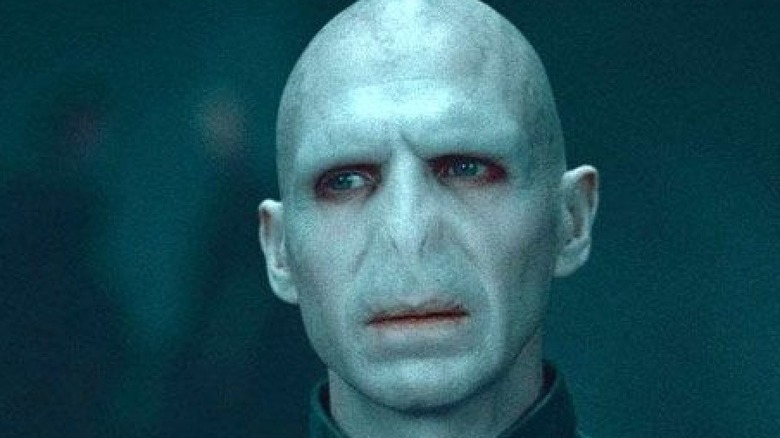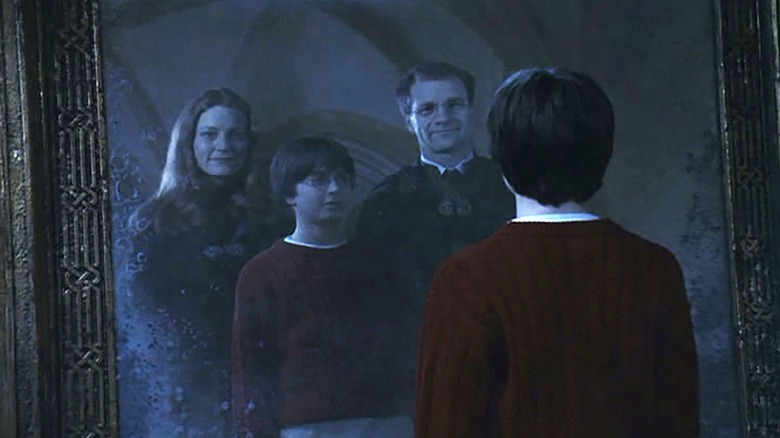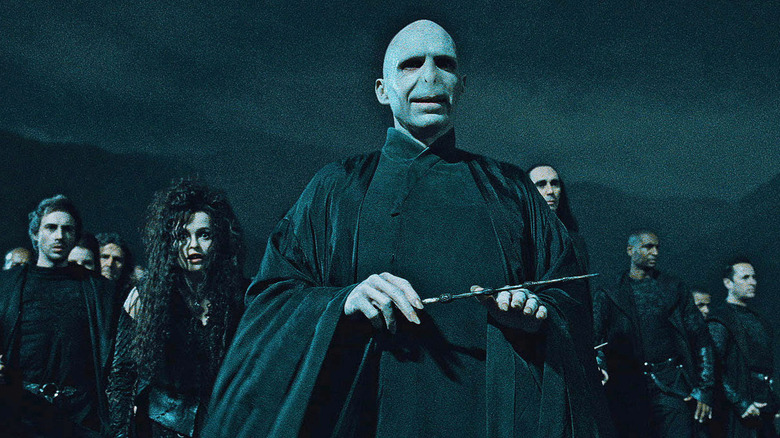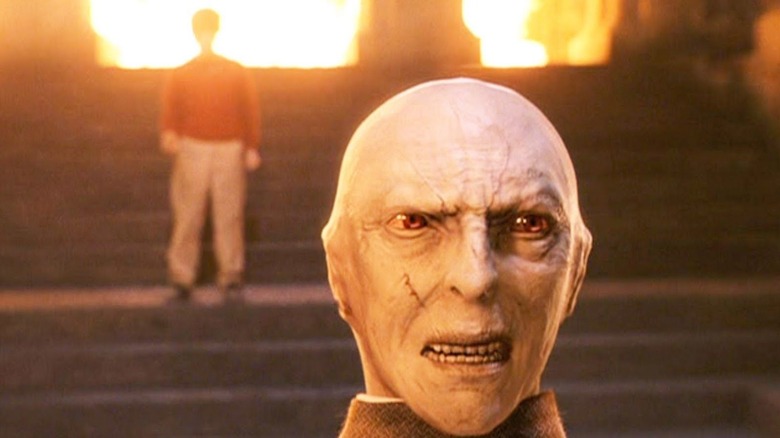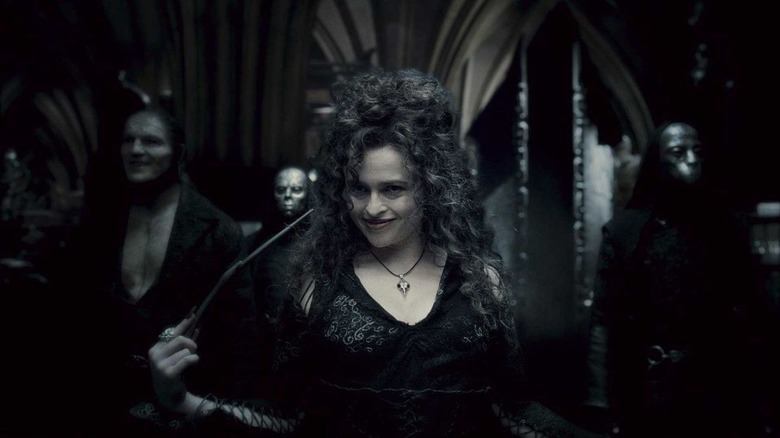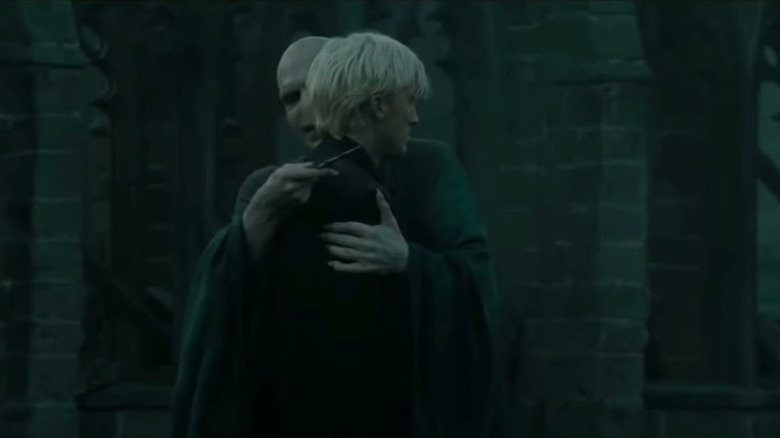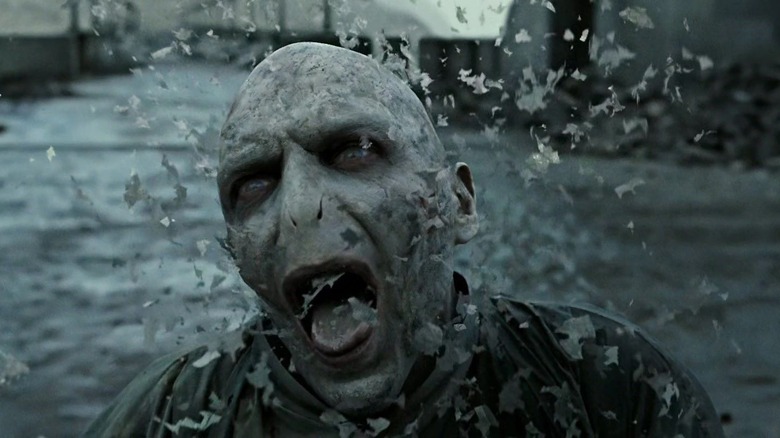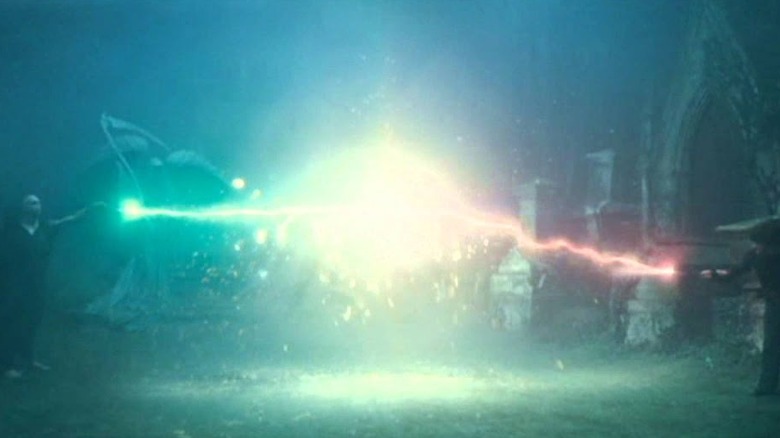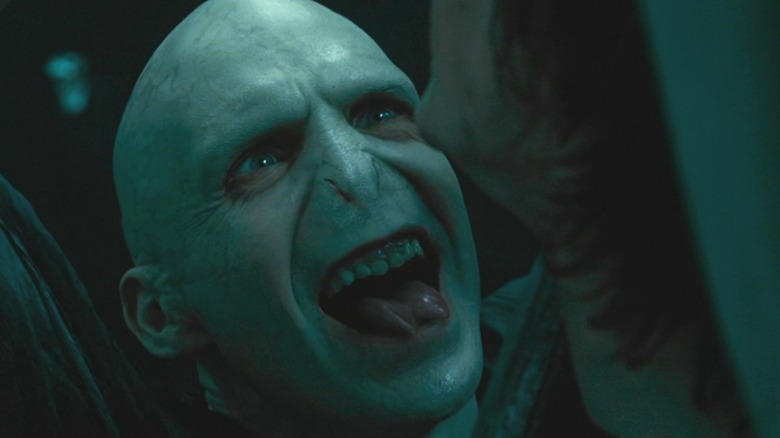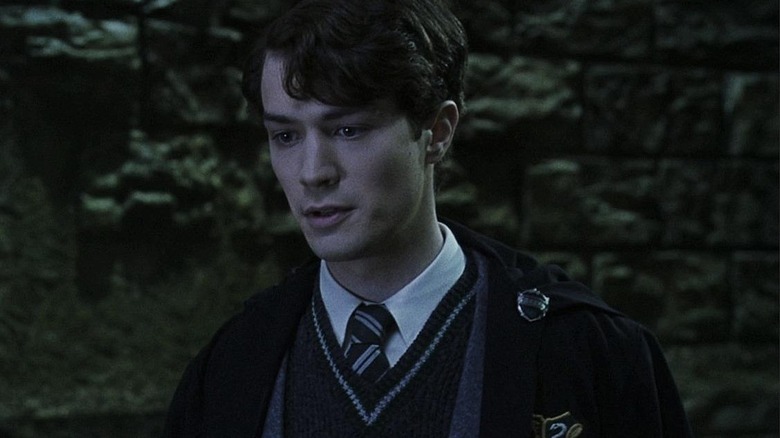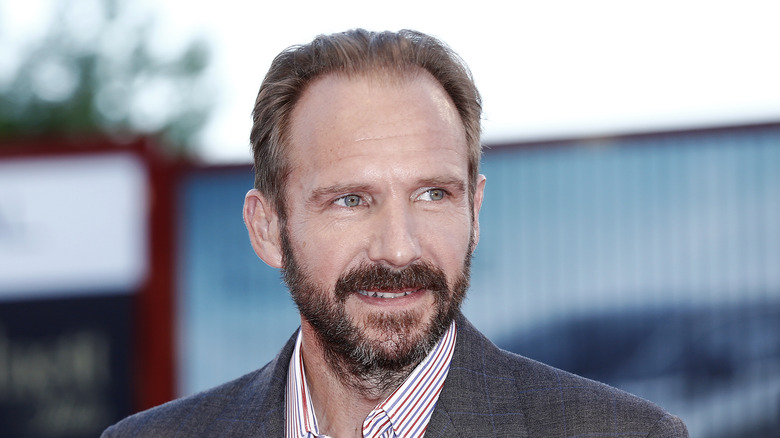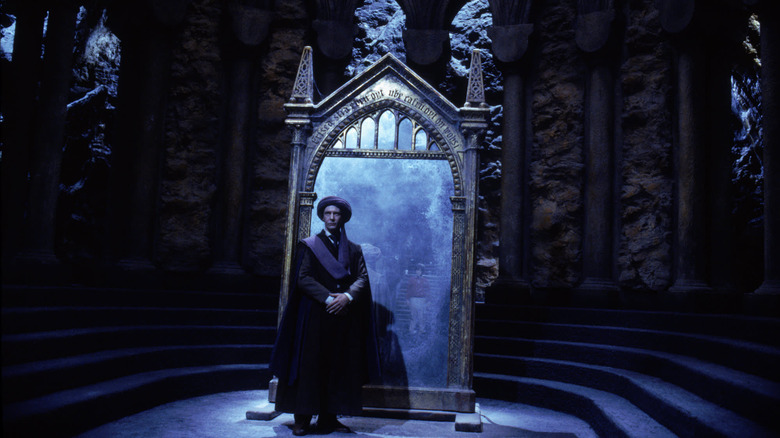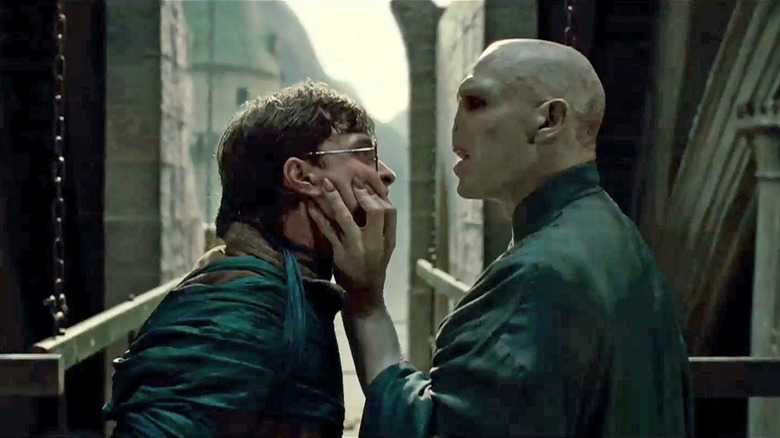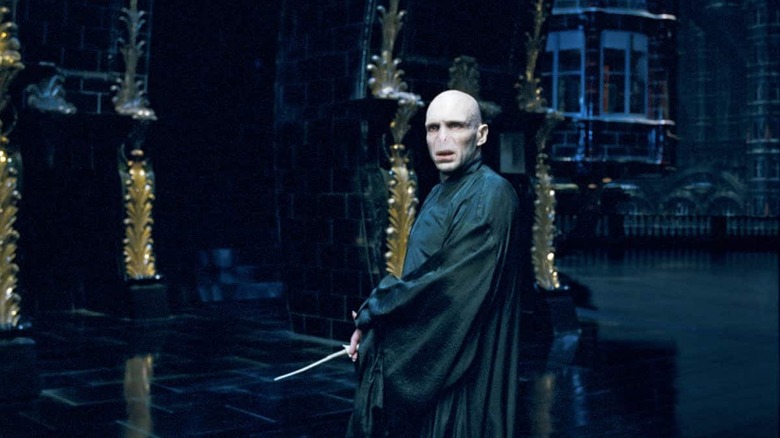The Untold Truth Of Voldemort
The "Harry Potter" franchise told the story of an eleven-year-old kid discovering he has special powers, whisked off to learn magic at Hogwarts School of Witchcraft and Wizardry. This simple premise gave birth to 7 best-selling novels and one of the most popular film and gaming franchises of all time.
As with any great drama, Harry's path to happiness was marred, however, by the presence of a memorable villain. The dreaded evil wizard, Lord Voldemort.
So fearsome was Voldemort's reputation that the wizarding world collectively refused to utter his very name, instead referring to him as "He-Who-Must-Not-Be-Named" or simply "You-Know-Who." It took the combined might of Harry and his allies, along with generous amounts of luck, to finally put an end to the terror brought upon the world by Voldemort and his minions.
As the series progressed, readers got to know more about Voldemort and the journey he had taken to become the most feared wizard of all time. Over the years, various bits and pieces of information have been added to the backstory by series creator J.K. Rowling. Here are 14 such (spoiler-heavy) points of interest that shed light on the inner workings of He-Who-Must-Not-Be-Named.
Part of Harry's backstory
Given how vital a character Voldemort is, you would think he'd be one of the first J.K. Rowling fleshed out while creating the Harry Potter's world. But that is far from the case. In an interview for The Diane Rehm Show in 1999, Rowling explained that at first, Voldemort was simply a background detail in the backstory for Harry she created in her mind.
"I saw Harry very very very clearly," Rowling stated about how she first got the idea for the series. "Very vividly. And I knew he didn't know he was a wizard... And I knew that *he* didn't know what he was." With this central premise in place, Rowling started thinking about the possible reason why Harry would not know about his wizarding heritage. The answer she came up with gave birth to the character of Lord Voldemort, the most evil wizard in the world, who had killed Harry's parents and forced him into exile, away from the wizarding world.
So, Voldemort was created for the first novel to explain Harry's ignorance about his wizarding heritage until he enrolled at Hogwarts. With each subsequent novel, Rowling fleshed out more of the character's backstory, turning Voldemort from a stereotypically one-dimensional "Dark Lord" into someone with a rich backstory and plausible motivations behind his twisted actions.
The missing parts of his personality
Throughout the Potter saga, we see Voldemort indulge in many horrific forms of cruelty. He started killing people as a teenager (back when Voldemort was known by his birth name, Tom Riddle Jr.) and Voldemort's misdeeds only grew in numbers and cruelty as he became older, until he became the dreaded Dark Lord whose name wizards fear to utter.
When looking at such a twisted character, you have to wonder how he could bring himself to inflict so much cruelty on the world. According to J.K. Rowling, Voldemort is simply a full-blown psychopath missing the parts of his personality that allow for empathy towards others. "You have Voldemort, a raging psychopath," Rowling stated in a 2000 interview with EW. "[Voldemort is] devoid of the normal human responses to other people's suffering."
This inability to understand or appreciate the concept of love and caring for others ultimately resulted in Voldemort's downfall. Time and again he underestimated the extent of love that Harry received from his allies, and that Harry himself would be willing to lay down his life to save friends and family. That final act of self-sacrifice is what allowed Harry to gain mastery over Voldemort's wand and destroy the evil wizard once and for all.
The first Voldemort actor
With the explosive popularity of the Potter books, Hollywood soon came calling. The series got its first live-action movie adaptation with "Harry Potter and the Sorcerer's Stone." The movie presented Harry's first year at Hogwarts when he was just beginning to uncover the secrets behind his wizarding legacy and its connections to Voldemort.
One of the main characters in the movie was Professor Quirrell (Ian Hart), the Defense Against the Dark Arts teacher at Hogwarts. While Quirrell appears to be a timid, cowardly individual, it all turns out to be an act. Quirrell was actually a servant of Voldemort, who carried his master around in his weakened state, and even allowed the Dark Lord to share his body.
In one of the most terrifying scenes in the "Harry Potter" films, we see Voldemort's head growing out of the back of Quirrell's skull. The actor you see playing Voldemort in the scene is Richard Bremmer, after getting a CGI makeover to make his features more twisted and diabolical. After that, two-time Oscar nominee Ralph Fiennes was tapped to play the live-action version of a newly-resurrected Voldemort in his own body, beginning with 2005's "Harry Potter and the Goblet of Fire."
Voldemort got it on with one of the Death Eaters
Lord Voldemort, as he appears in the "Harry Potter" books and movies, is many things. But a heartthrob, he ain't. Sure, Tom Riddle Jr. used to be a strikingly handsome man who had no trouble charming women, but ever since he transformed into Lord Voldemort his sole aim became to inspire fear and awe in everyone he met.
But despite the wretched, snake-like appearance that Voldemort became famous for, there was one follower among his ranks who felt deep, sensual passion towards him. That person was the Death Eater Bellatrix Lestrange (played in the films by Helena Bonham Carter). Despite being married already, Bellatrix's first and greatest love was Lord Voldemort, and she willingly spent decades living a miserable life in the wizarding prison Azkaban rather than renounce her Dark Lord after his fall.
Bellatrix's loyalty made her one of Voldemort's most valuable lieutenants after he regained his body and gathered his servants around him once more. But their relationship went deeper than that. In the play "Harry Potter and the Cursed Child," it is revealed that Voldemort and Bellatrix got intimate at some point. This resulted in the conception of their daughter Delphini, who later plotted to bring her father back with the help of time-traveling magic.
The improvised hug
Film adaptations of popular books are rarely a case of simply transposing the written text onto the screenplay. The "Harry Potter" movies made plenty of departures from the books over the years, from cutting out important scenes and characters like Peeves the Poltergeist, to adding in new material that sometimes left fans scratching their heads.
One case of the latter occurred at the end of "Harry Potter and the Deathly Hallows II." Voldemort brings his entire Death Eater army into Hogwarts for a final standoff against Harry and his allies at the school. In the middle of the pitched battle, Voldemort unexpectedly hugs Draco (Tom Felton) in a sign of affection that the Dark Lord had never shown another human being before.
Draco looks suitably shocked in the moment, which was not entirely acting. Felton has explained in the past that the hug was a bit of improv that Ralph Fiennes did for the scene during multiple retakes. "He only hugged me once [in 25 takes]," Felton told audiences during a 2011 interview at DragonCon. "It was very strange. It was a surprise to me. I was baffled. I'm even more baffled that that was the take they used."
Voldemort had one great fear
While he was cruel and powerful, what made Voldemort truly dangerous was his complete absence of fear in the face of any kind of adversity. The man had travelled far and wide before becoming the Dark Lord, encountered all sorts of dangerous magical creatures and criminal wizards in the process, always emerging triumphant no matter what the odds.
The popular supposition was that Voldemort was afraid of Albus Dumbledore. But even that could not be termed true "fear." Voldemort shrewdly acknowledged that Dumbledore was a more skilled wizard than him. But instead of avoiding a fight against the latter, Voldemort chose more sneaky methods to ultimately bring about the fall of Dumbledore at the hands of Severus Snape.
As powerful and fearless as Voldemort looked, he did have one great fear that ruled his life and dictated his actions: a fear of dying and being forgotten.
"Voldemort's fear is death, ignominious death," J.K. Rowling explained in an interview for The Leaky Cauldron. "I mean, he regards death itself as ignominious. He thinks that it's a shameful human weakness, as you know. His worst fear is death." It was this great, overriding fear that led Voldemort to create the six horcruxes, thinking he could cheat death forever.
When Voldemort made Rowling cry
As complex a character as Voldemort is, his primary aim was to act as a villain in Harry Potter's personal journey. As such, the most significant action that Voldemort takes in the entire series, narratively speaking, is the murder of Harry's parents when he was only a year old.
It was this act that forced Harry to grow up an orphan, divorced from his wizarding heritage until he got accepted into Hogwarts. The same incident also destroyed Voldemort's body and left him close to death. Harry and a newly-resurrected Voldemort are reunited years later in "Harry Potter and the Goblet of Fire." In the middle of their duel, a special magical connection is created, forcing Voldemort's wand to bring forth the spirits of its murdered victims.
Of course, the victims include Harry's parents Lily and James Potter. For one brief moment, Harry is actually able to talk to them while Voldemort can only look on in confused horror. The scene was so emotional that it moved J.K. Rowling to tears while she was writing it.
"It was the first time I cried writing a Harry Potter book," Rowling admitted in a 2000 interview. "I got pretty upset."
The missing forked tongue
The film "Harry Potter and the Goblet of Fire" was a special occasion for Potter fans because the climax of the movie featured the first proper live-action appearance of Lord Voldemort in his full glory. Fans were eager to see whether Ralph Fiennes would be able to do justice to a character already established via the written word as the most evil, fearsome wizard in the entire series.
The filmmakers were aware of such expectations, and spared no effort in living up to them, perhaps going a bit overboard in the process. Lord Voldemort was depicted as a bald, snake-like being in accordance with his description in the books. Additionally, he was shown to have a forked tongue like a literal snake, making him look even more demonic and otherworldly.
That forked tongue bit may have been a bit of an overkill on the part of the movie, and its makers seemed to agree. Later versions of Voldemort in subsequent films dropped the forked tongue, and generally made the character look more like a human and less demonic.
The changing appearance
Many characters went on epic journeys throughout the "Harry Potter" series, but arguably none more so than Lord Voldemort himself. Apart from his emotional journey from an orphaned childhood to wizarding adulthood, Voldemort also underwent an intense physical journey that horrifically transformed him appearance forever.
At first, Tom Riddle Jr. was an intensely handsome young man who knew how to use his good looks to charm others. But gradually, after embarking on many solo journeys around the world, Riddle's appearance began to undergo a terrifying change. His handsome visage appeared to melt and rearrange into a barely-human semblance that came to be Lord Voldemort's terrifying look. As readers learned in "Harry Potter and the Half-Blood Prince," the reason for Riddle's changed appearance was due to the creation of his six horcruxes.
The magical items could grant a wizard immortality, but at the expense of ripping the user's soul to shreds. According to Dumbledore, with each new horcrux he made, Voldemort's soul grew more feeble and damaged from being continuously ripped apart, which also resulted in his frightening physical transformation into a less-than-human creature.
"Lord Voldemort has seemed to grow less human with the passing years," Dumbledore points out in "Harry Potter and the Half-Blood Prince," adding, "the transformation he has undergone seemed to me to be only explicable if his soul was mutilated beyond the realms of what we might call 'usual evil.'"
Ralph Fiennes was not initially a fan of the series
While the majority of the main cast of "Harry Potter" remained the same from the first movie, Ralph Fiennes was a late arrival in the role of Lord Voldemort in "Harry Potter and the Goblet of Fire." By then, the franchise had already become a worldwide phenomenon with a high level of scrutiny on any new actor, especially one who was set to play the main villain of the entire series.
For his part, Fiennes was able to sidestep the weight of expectations. The actor had already enjoyed a distinguished career in films and on the stage for many years, and came on to the "Harry Potter" sets as a professional looking to get on with his job rather than as a nervous fanboy. "I admire the world of the books," Fiennes stated in a 2005 interview. "And the characters that [Rowling has] created, but I'm not, as it were, an addict of Harry Potter."
While the actor was able to keep a certain detached distance from the world of "Harry Potter" at the start, Fiennes eventually grew quite attached to the role of Lord Voldemort. So much so that he declared recently that he would not want to see any other actor play the part in the "Fantastic Beasts" films.
"I feel a kind of affection for Voldemort," Fiennes said to the BBC. "So if there was a world in which Voldemort came back, I would be very possessive about wanting to reprise that."
What Voldemort really desires
As much as the "Harry Potter" films depict a world of magic where anything is possible, it is also a story about dealing with things you cannot change and unfulfilled desires that may haunt you for the rest of your life. The most literal manifestation of this theme can be seen in the "Mirror of Erised," which shows the person standing in front of it their deepest unfulfilled longings and desires.
When Harry spends time with the mirror in his first year at Hogwarts, he sees himself standing alongside his deceased mother and father and the rest of their family. Ron sees himself being more successful and popular than his brothers. Meanwhile, it has been strongly hinted in the final novel that Dumbledore saw himself in the Mirror of Erised reunited with his sister Ariana, whose death, possibly at his own hands, had been a source of never-ending guilt for Dumbledore for decades.
So what might someone like Lord Voldemort see if he were to gaze into the Mirror of Erised? Unsurprisingly, Voldemort's deepest desires relate to his own triumphs rather than any loved ones.
"[Voldemort would see] himself," Rowling stated in an interview with The Leaky Cauldron. "All-powerful and eternal. That's what he wants." By the same token, Rowling also mentioned in the interview that Voldemort's greatest fear given physical shape by a Boggart would be seeing himself as a corpse.
Voldemort and Harry are related
Right from the start of the "Harry Potter" saga, Harry and Voldemort are positioned as two people on opposite ends of humanity's spectrum. While Harry is kind, empathetic and craves love and acceptance, Voldemort is cruel, completely callous, and sees all of humanity as beneath himself.
The differences between the two only grow more pronounced with each subsequent book in the series, even as a few similarities between them emerge. Both Harry and Voldemort grew up as half-blood orphans unaware of their wizarding heritage until enrolling at Hogwarts. In fact, Voldemort saw so much of himself in Harry that he chose the young wizard as his true rival as earmarked by a prophecy instead of Neville Longbottom, who also had a shot at being Voldemort's destined mortal enemy.
In the final book, it is revealed that not only are Harry and Voldemort similar in many ways, but they are also related by blood. Both characters are descended from the Peverell brothers who created the "Deathly Hallows," and as such both count two of the three Hallows as family heirlooms. This means that Harry and Voldemort are distant cousins, and their war could be described as something of a family feud, with the fate of the wizarding world at stake.
Why love baffled Voldemort
Right from the first novel in the "Harry Potter" series, Albus Dumbledore was fond of telling Harry that "love" is the greatest form of magic in existence. It was love that made Lily Potter shield her son with her dying breath, which ultimately proved the one magical barrier Voldemort's curse could not penetrate, leading to his initial defeat.
After Voldemort was resurrected in the fourth book, Dumbledore continued to tell Harry that love would be the path through which he would finally be able to defeat Voldemort, something Harry found difficult to believe. In the final book, during his last confrontation with Harry, Voldemort himself made fun of how much faith Dumbledore put in love, an emotion that the Dark Lord held in deep contempt, which ultimately led to his downfall at the hands of Harry.
According to J.K. Rowling, the reason Voldemort was never able to understand the power of love was because he was conceived from a literally loveless marriage, since his mother kept his father enslaved under the spell of a love potion, and Tom Riddle Jr. subsequently grew up an orphan.
"It was a symbolic way of showing that he came from a loveless union," Rowling explained in an interview with Bloomsbury.com (via The Leaky Cauldron). "But of course, everything would have changed if Merope had survived and raised him herself and loved him."
The significance of the wands
The most important source of connection between Harry and Voldemort was their wands. In the first book, when Harry receives his brand-new wand from Mr. Ollivander, he is informed that the special phoenix feather in his wand has a unique twin that resides in the wand of the Dark Lord himself.
While this connection would eventually save Harry's life during a crucial battle with Voldemort, the composition of their respective wands was also a source of special significance. "I gave Harry a wand made of holly wood back in 1990," J.K. Rowling wrote on her site. "Holly has certain connotations that were perfect for Harry, particularly when contrasted with the traditional associations of yew, from which Voldemort's wand is made."
Rowling goes on to explain that the traditional lore in Europe is that holly can be used to repel evil, whereas yew, with its poisonous sap, symbolizes death and resurrection. So, the story of Voldemort's evil being vanquished at the hands of Harry and his subsequent resurrection can be symbolically represented by their respective wands.
